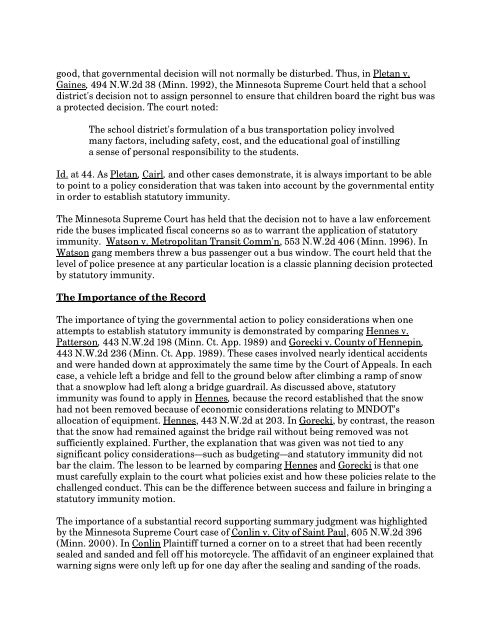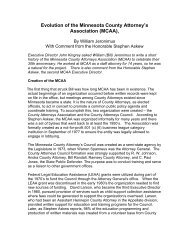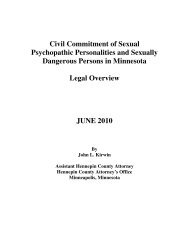Governmental Immunities: - Minnesota County Attorneys Association
Governmental Immunities: - Minnesota County Attorneys Association
Governmental Immunities: - Minnesota County Attorneys Association
You also want an ePaper? Increase the reach of your titles
YUMPU automatically turns print PDFs into web optimized ePapers that Google loves.
good, that governmental decision will not normally be disturbed. Thus, in Pletan v.<br />
Gaines, 494 N.W.2d 38 (Minn. 1992), the <strong>Minnesota</strong> Supreme Court held that a school<br />
district's decision not to assign personnel to ensure that children board the right bus was<br />
a protected decision. The court noted:<br />
The school district's formulation of a bus transportation policy involved<br />
many factors, including safety, cost, and the educational goal of instilling<br />
a sense of personal responsibility to the students.<br />
Id. at 44. As Pletan, Cairl, and other cases demonstrate, it is always important to be able<br />
to point to a policy consideration that was taken into account by the governmental entity<br />
in order to establish statutory immunity.<br />
The <strong>Minnesota</strong> Supreme Court has held that the decision not to have a law enforcement<br />
ride the buses implicated fiscal concerns so as to warrant the application of statutory<br />
immunity. Watson v. Metropolitan Transit Comm'n, 553 N.W.2d 406 (Minn. 1996). In<br />
Watson gang members threw a bus passenger out a bus window. The court held that the<br />
level of police presence at any particular location is a classic planning decision protected<br />
by statutory immunity.<br />
The Importance of the Record<br />
The importance of tying the governmental action to policy considerations when one<br />
attempts to establish statutory immunity is demonstrated by comparing Hennes v.<br />
Patterson, 443 N.W.2d 198 (Minn. Ct. App. 1989) and Gorecki v. <strong>County</strong> of Hennepin,<br />
443 N.W.2d 236 (Minn. Ct. App. 1989). These cases involved nearly identical accidents<br />
and were handed down at approximately the same time by the Court of Appeals. In each<br />
case, a vehicle left a bridge and fell to the ground below after climbing a ramp of snow<br />
that a snowplow had left along a bridge guardrail. As discussed above, statutory<br />
immunity was found to apply in Hennes, because the record established that the snow<br />
had not been removed because of economic considerations relating to MNDOT’s<br />
allocation of equipment. Hennes, 443 N.W.2d at 203. In Gorecki, by contrast, the reason<br />
that the snow had remained against the bridge rail without being removed was not<br />
sufficiently explained. Further, the explanation that was given was not tied to any<br />
significant policy considerations—such as budgeting—and statutory immunity did not<br />
bar the claim. The lesson to be learned by comparing Hennes and Gorecki is that one<br />
must carefully explain to the court what policies exist and how these policies relate to the<br />
challenged conduct. This can be the difference between success and failure in bringing a<br />
statutory immunity motion.<br />
The importance of a substantial record supporting summary judgment was highlighted<br />
by the <strong>Minnesota</strong> Supreme Court case of Conlin v. City of Saint Paul, 605 N.W.2d 396<br />
(Minn. 2000). In Conlin Plaintiff turned a corner on to a street that had been recently<br />
sealed and sanded and fell off his motorcycle. The affidavit of an engineer explained that<br />
warning signs were only left up for one day after the sealing and sanding of the roads.<br />
<strong>Governmental</strong> <strong>Immunities</strong> Handbook<br />
Kenneth H. Bayliss<br />
Quinlivan & Hughes, P.A. © 2010<br />
7






